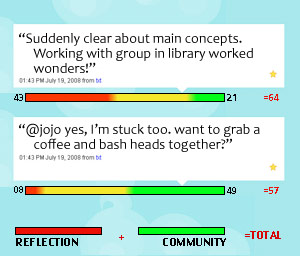Following a very thought-provoking post by Alan Cann:
http://scienceoftheinvisible.blogspot.com/2009/02/dont-mention-b-word.html
…I’ve been mulling it over with a coffee. His post talks about his students’ dislike for reflectve writing in blogs – mainly due to the time and thought it requires. It combines two key topics (reflection and modern, appropriate, assessment) – both of which are vital, I think, for the near future in education.
Myself and Alan have already tweeted about the difference in expectation/ease of reflection in Arts/Sciences, which means that some longer forms (blogs, wikis) do work to a certain extent in Arts subjects, contrary to Science contexts. However, this still leaves two problems: reflection for scientists (that could be a conference in its own right, no?!) and appropriate and clear assessment.
For the first, I like the idea of micro- or mini- blogging. short statements which encourage instant and secondary reflection (just finishing a class/activity, and in the evening – for example) combined with communal comparison (‘I thought bit X was really unclear: I can’t see how it fits in’ / ‘I agree – foxed me too. Anyone get it?’) We know scientists talk in single sentences 😉 so Twitter (or my proposed 300-character mini blogging service, Yakkus) might be just the thing.

Visual Assessment Guidelines
For assessment, I’ve had the same problem as Alan. Complaints from students that it’s too difficult to comprehend; increasingly convoluted attempts to express it. With micro- mini- blogging, this should be easier. A string of sample tweets/yakks down the page, each with a green-yellow-red coloured bar indicating the depth of reflection and collaboration (see example at side). At-a-glance assessment guidelines.
The more I think about this, the more I like it. Any thoughts from the scientists?

